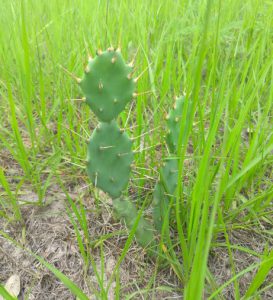Prickly Pear Cactus Weed in the Pasture
Livestock owners are used to dealing with a wide range of weeds that can infest the pasture. Some of these weeds posed mere annoyances while others can just be downright hazardous. One of those hazardous weeds is called Prickly Pear Cactus, which can be found on dry, sandy soils and can be very problematic in pastures. This weed can reproduce from each cactus pad, becoming an issue if pasture managers decide to try to eliminate the weed by mowing. Some weeds can be reduced by mechanically mowing, but this method will actually fragment the cactus and increase the infestation. Another issue with prickly pear is that grazing animals can be severely injured by the cactus quills if they forage too closely. These quills can be difficult to remove and often break off still lodged in the skin, potentially causing infections.

Photo Credit: Luke Harlow
Since cattle and livestock are aware of the dangers of the cactus, they generally will avoid grazing in the general vicinity. This loss of grazing area can greatly decrease the amount of available or usable forage in a pasture, thus reducing livestock productivity. Because the cattle will not graze close to a single prickly pear, a 6 to 8-inch perimeter of ungrazable grass is created around the plant.
According to a study performed by the University of Wyoming, if a pasture producing 1,000 pounds of forage per acre per year develops a 20 percent cactus infestation, 30 to 40 percent of the forage becomes useless. Losing 35 percent of the forage means that a producer can lose 350 pounds of dry matter per acre per year. (Taylor and Whitson, 1999)
Prickly Pear Control
For small infestations of prickly pear, mechanically removal of the whole plant, including the roots is recommended. For larger infestations, several herbicide options exist for control in the pastures. Recent experiments conducted at UF/IFAS have found that broadcast applications of Vista XRT and TrumpCard herbicide at recommended rates can effectively control prickly pear. It is important to note that herbicide methods will take time and control of the prickly pear is not rapid. After application, treated cactus quills turn gray and cactus pads will swell and turn green/gray and the prickly pear can remain in this status for 6-8 months. Depending on the severity of the infestation, re-treatment may be needed.

Photo Credit: Jay Ferrell
For more detailed information on Prickly Pear Cactus management in pastures, please read the follow document:
Prickly Pear Cactus Control in Pastures
If you are concerned about how to treat this troublesome weed, or have questions regarding any other weeds within your pasture, please contact your local UF/IFAS county extension agent.
 0
0
